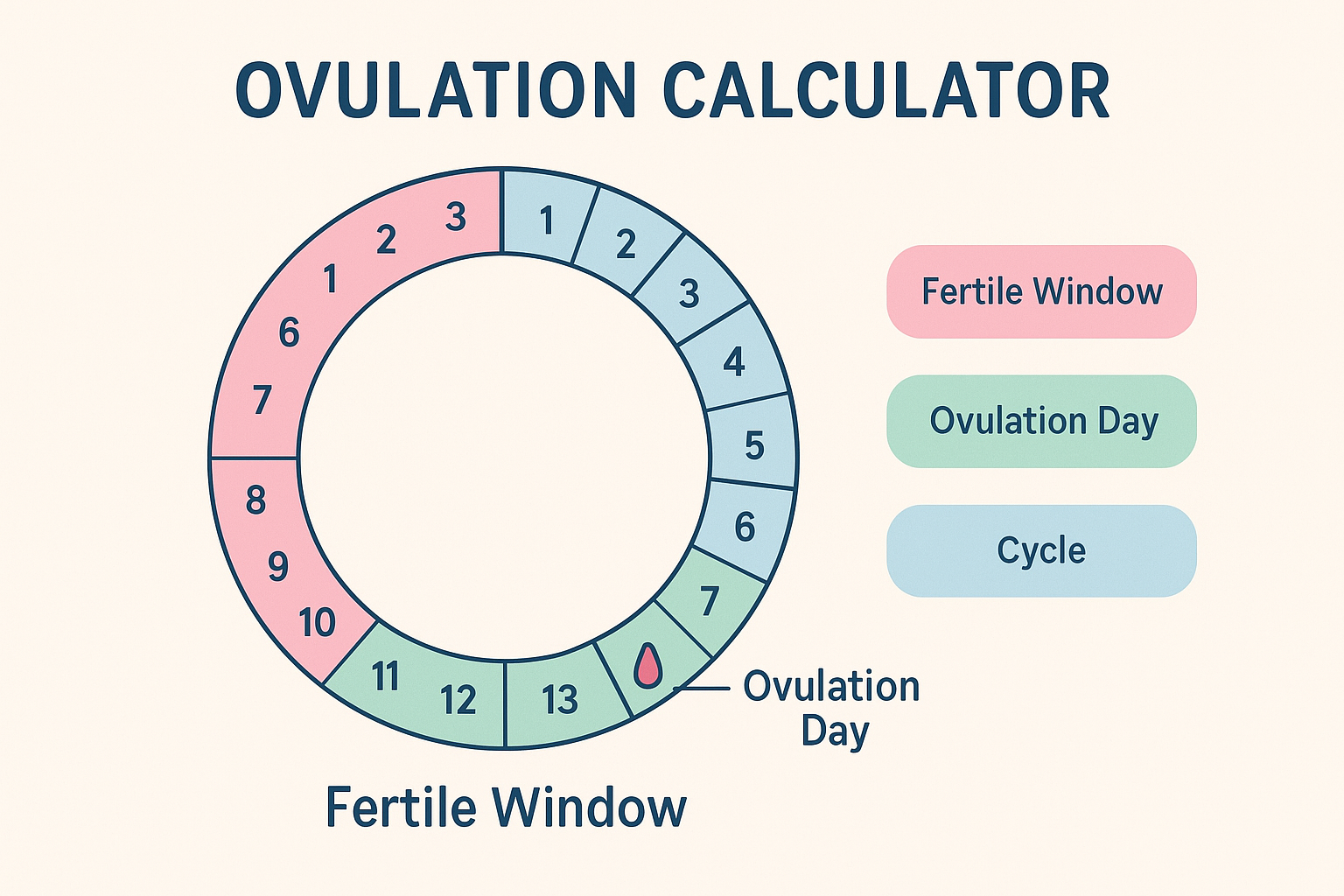Ovulation Calculator & Calendar
Track your ovulation days and fertile window with ease
Next Period
-
Ovulation Day
-
Fertile Window
-
Cycle Length
-
Note: This calculator gives estimates only. For medical advice, consult your doctor.
Track Your Fertile Days Accurately With an Ovulation Predictor
Understanding your fertile window can make planning a pregnancy much easier. Tools like an ovulation predictor help you estimate the days when your chances of conceiving are highest. Whether your cycle is regular, irregular, or you are recovering from a miscarriage, tracking ovulation gives valuable insight into your reproductive health.
Ovulation and Fertility Tracking Chart
A fertility chart or tracker highlights:
Your fertile days
Likely ovulation date
Cycle patterns for better pregnancy planning
Visual tools help you see at a glance when conception is most likely.

What Is an Ovulation Calculator?
An ovulation calculator predicts when ovulation—your egg release—is likely to occur during your menstrual cycle. Since ovulation usually happens about 14 days before your next period, knowing this window can help identify your fertile days. During these few days, your chances of conception are highest.
Most online ovulation calculators, such as the Clearblue Ovulation Calculator, use your cycle length, last period date, and luteal phase duration to calculate your estimated ovulation date and fertility window. This tool is especially helpful if you want to plan conception with greater precision and track your fertile days accurately.
How It Works
Most tools calculate ovulation based on your last menstrual period (LMP) and your average cycle length. For example:
If you have a 28-day cycle, ovulation usually occurs on day 14.
If you have a 35-day cycle, it likely happens around day 21.
The calculator then identifies your fertile window—the five days before and including your ovulation day.
You can try our Ovulation and Implantation Calculator to estimate both your fertile days and when implantation may occur if conception takes place. Once you conceive, try our Due Date Calculator to estimate when your baby will arrive based on your ovulation or conception date.
Tracking Ovulation With Irregular Periods
Irregular cycles make prediction harder, but an irregular cycle ovulation tool can help by averaging your last 3–6 cycles. Accuracy improves when combined with:
Basal body temperature (BBT) tracking
Observing cervical mucus changes
Using ovulation test kits
These methods help even women with varying cycle lengths predict fertile days more reliably.
Ovulation After Miscarriage
After a miscarriage, your hormones take time to stabilize. Ovulation may resume as soon as 2–4 weeks afterward. Using an ovulation after miscarriage calculator helps you understand when your body is ready to conceive again.
If you are unsure when your cycle returns to normal, our Calculate Ovulation After Miscarriage Tool can guide you based on the date your miscarriage occurred and your previous cycle pattern.
Remember: every woman’s recovery is unique—consult your doctor before trying to conceive again to ensure your body is ready.
Ovulation After Birth Control or Abortion
Stopping pills or experiencing an abortion may temporarily delay ovulation. Tracking at least two cycles provides a clearer picture. A post-pill or post-abortion ovulation calculator estimates your fertile window and likely ovulation date, helping plan conception safely.
Ovulation Calculator for Twins and Gender Prediction
While ovulation calculators cannot guarantee baby gender or twins, some people use timing strategies to increase chances naturally.
Gender Prediction (Shettles Method)
For a boy: intercourse closer to ovulation
For a girl: intercourse 2–3 days before ovulation
Keep in mind this is not 100% scientific.
Twins
Twin pregnancies may be slightly more likely when:
Ovulation produces two eggs (hyperovulation)
Fertility medications like Clomid or Letrozole are used
There’s a family history of twins
An ovulation calculator for twins helps estimate fertile days but cannot guarantee twin conception.
Ovulation and Implantation Timeline
After ovulation, if an egg is fertilized, implantation usually happens 6–10 days later. Using an ovulation and implantation calculator helps estimate:
When ovulation occurs.
When implantation might take place.
The earliest date you can take a pregnancy test.
For example:
If ovulation occurs on November 10, implantation may happen between November 16–20.
You could take an early pregnancy test about 10–12 days after ovulation.
Ovulation for PCOS or Fertility Medication Users
Women with Polycystic Ovary Syndrome (PCOS) often have unpredictable cycles. A PCOS ovulation calculator combines cycle history and hormonal tracking to improve prediction accuracy.
For women taking Clomid or Letrozole, an ovulation calculator can help determine likely ovulation days after finishing medication, usually 5–10 days after the last pill.
Frequently Asked Question
What is the most accurate ovulation calculator?
The most accurate ovulation calculator is the one that uses your average cycle length and last period date. Combining it with physical signs like cervical mucus and basal body temperature makes results more precise.
How to calculate ovulation if I have irregular periods?
If your periods are irregular, track your cycle for a few months and use an ovulation calculator that adjusts for variable lengths. Ovulation usually occurs about 14 days before your next period.
Can I use an ovulation calculator after a miscarriage?
Yes, once your cycles return to normal, you can use an ovulation calculator to estimate fertile days. However, wait until your doctor confirms it’s safe to try again.
Can an ovulation calculator predict baby gender?
Some people use timing theories to influence gender, but ovulation calculators can’t guarantee a baby’s gender—they only help identify your fertile window.
How reliable is an ovulation calculator when I have irregular cycle lengths?
Ovulation calculators are less reliable for women with highly irregular cycles. It’s best to track additional ovulation symptoms or use ovulation test kits for better accuracy.
How long does the fertile window last after ovulation?
The fertile window usually lasts about 6 days—five days before ovulation and the day of ovulation itself.
